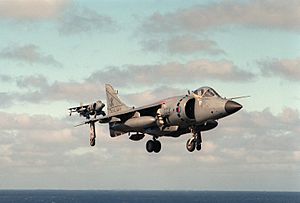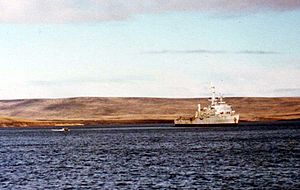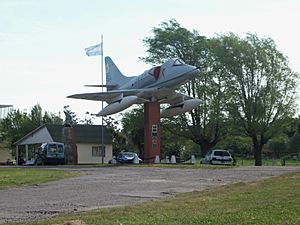Battle of San Carlos (1982) facts for kids
Quick facts for kids Battle of San Carlos |
|||||||
|---|---|---|---|---|---|---|---|
| Part of the Falklands War | |||||||
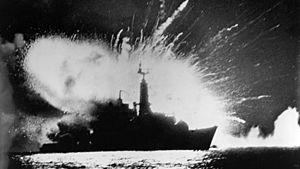 HMS Antelope explodes on 23 May |
|||||||
|
|||||||
| Belligerents | |||||||
| Commanders and leaders | |||||||
| Strength | |||||||
| 2 destroyers 7 frigates 11 landing ships Sea Harrier CAPs |
90 fighter-bombers on the mainland 2 KC-130 Hercules tankers 10 attack aircraft on the islands |
||||||
| Casualties and losses | |||||||
| 1 destroyer sunk 2 frigates sunk 8 ships damaged 4 helicopters lost 49 killed |
22 aircraft lost 11 killed |
||||||
The Battle of San Carlos was an important fight between planes and ships during the Falklands War in 1982. It happened from May 21 to 25, 1982, when British forces were landing on the shores of San Carlos Water. This area became known as "Bomb Alley" because of the intense air attacks. Argentine jet planes, flying low from the mainland, repeatedly attacked the British ships.
This battle was special because it was the first time a modern navy, with missiles and air support from aircraft carriers, defended against such big air attacks. The British ships were damaged and some were lost, but they successfully landed their troops and set up a safe area on the islands.
Contents
Why the Battle Happened
After Argentina took over the Falkland Islands in 1982, the United Kingdom started Operation Corporate. This was a plan to send a large group of ships and soldiers, called a Task Force, over 12,000 kilometers (about 7,500 miles) to take the islands back.
The British planned to land their troops around San Carlos. This place was chosen because the surrounding hills would protect the landing force from enemy missiles and submarines. It was also far enough from Stanley, where many Argentine troops were stationed, to prevent a quick attack.
The landing caught the Argentines completely by surprise. Argentine Navy officers had thought San Carlos was not a good place for a landing, so they left the area without strong defenses.
Argentine Air Power
After the Argentine Navy's main ships stayed in port, the job of fighting the British landings mostly fell to the pilots of the Argentine Air Force (FAA) and the Argentine Naval Aviation (COAN). They faced big challenges because their targets were very far away, and they had limited ways to refuel their planes in the air.
The main attack aircraft for both the Air Force and Navy was the A-4 Skyhawk. These planes were bought from the US Navy in the late 1960s and early 1970s. They often needed two aerial refuelings during their missions. They carried bombs and had cannons, but the cannons were not always reliable.
The Dagger, an Israeli copy of the French Mirage 5, was the Argentine Air Force's newest plane. These planes could not refuel in the air and flew at the very edge of their range to reach the islands. They carried bombs and powerful cannons.
Fighter planes like the Mirage IIIEAs were supposed to protect the attack aircraft. However, they had small fuel tanks and could not fly low enough to escort the attack planes. Even flying high, they could only stay over the islands for a few minutes.
On the islands themselves, there were no long runways for fast jets. So, less powerful planes were used. The Argentine-built FMA IA-58 Pucara could fly from grass airstrips, like the one at Goose Green. These planes were tough and had cannons, machine guns, and rockets. But they were not designed to attack well-defended targets. At Port Stanley Airport, the Argentine Navy used five Aermacchi MB-339 trainer planes for light attacks.
Near Stanley, the Argentines had a powerful radar system. This radar could spot British aircraft up to 40 miles away.
The British used aircraft carriers to provide air cover with their special Harrier jets. These jets could take off and land vertically or in short distances.
- Aircraft carrier HMS Hermes
- 800 Squadron (BAE Sea Harrier)
- 809 Squadron (BAE Sea Harrier)
- Aircraft carrier HMS Invincible
- 801 Squadron (BAE Sea Harrier)
- 809 Squadron (BAE Sea Harrier)
The landing force included several large ships like HMS Fearless and HMS Intrepid, along with many supply and transport ships. The escort force was made up of destroyers and frigates, such as HMS Antrim, HMS Coventry, and HMS Broadsword.
The Battle Days
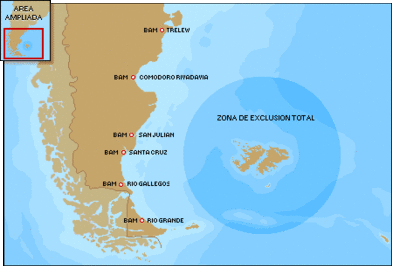
Because of the long flight, Argentine attack planes only had about two minutes over the target area.
May 21: The First Attacks
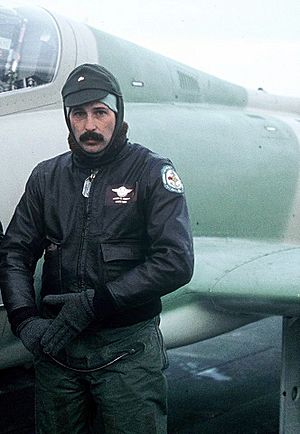
A small Argentine Army unit of 62 men was watching the area. They spotted the British fleet entering San Carlos during the night. They opened fire with mortars and rifles. British ships and a special forces team fought back. The Argentine unit had to retreat, losing their communication gear. However, they shot down two British Gazelle helicopters, killing three crew members.
An Argentine Aermacchi MB-339 jet from the islands flew over San Carlos to see what was happening. Meanwhile, the Argentine Air Force started launching planes from the mainland.
Throughout the day, Argentine Daggers and A-4Cs attacked British ships like HMS Antrim, HMS Argonaut, HMS Broadsword, HMS Brilliant, and HMS Ardent. Many of the bombs dropped did not explode. However, HMS Ardent and HMS Argonaut were hit and damaged, with some crew members injured or killed. British Sea Harriers intercepted some attackers, destroying 8 Argentine aircraft.
May 22: Bad Weather
HMS Ardent, which was badly damaged the day before, sank early in the morning. Bad weather over the Argentine airfields stopped most air missions. Only a few Skyhawks managed to reach the islands. The British finished setting up their Rapier missile defenses.
May 23: Antelope Sinks
Argentine planes attacked again. They hit HMS Antelope, HMS Broadsword, and HMS Yarmouth. Only HMS Antelope was badly damaged. It sank before dawn on May 24 after an unexploded bomb went off while being disarmed. Two attacking aircraft were shot down. Another Argentine pilot was killed when his parachute did not open fully after he ejected from his plane during landing.
May 24: Pilots Protest
On May 24, Argentine pilots openly complained about the lack of teamwork between their armed forces. They even protested by not flying. General Galtieri, Argentina's acting president, decided to visit them the next day to convince them to keep fighting. But by the time he arrived, the pilots had changed their minds and were already flying missions.
Six groups of planes attacked British forces. RFA Sir Lancelot was hit by a bomb that did not explode. Other supply ships were also attacked. Four Argentine attack planes were shot down, and one pilot was killed.
May 25: Coventry Sunk
Air Force attacks on May 25 were more successful. HMS Coventry was sunk after being hit by bombs. Attacks on HMS Broadsword damaged its communication systems and a helicopter. RFA Sir Lancelot was also attacked. One group of planes accidentally attacked Goose Green, thinking it was Ajax Bay, and was hit by friendly fire from their own troops. Three attacking planes were shot down by British defenses.
After the Battle
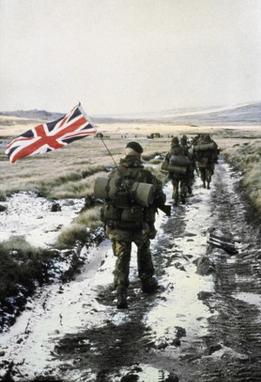
I think the Argentine pilots are showing great bravery, it would be foolish of me to say anything else
Even with the strong British air defenses, Argentine pilots managed to attack their targets. However, many of their bombs did not explode. Thirteen bombs hit British ships without going off. Some experts later said that if these bombs had exploded, the British might have lost the battle.
The British warships, even though they took most of the attacks, successfully kept the Argentine planes away from the landing ships. These landing ships were safely inside the bay. With British troops now on the Falkland Islands, a land campaign followed. Argentine General Mario Menéndez surrendered to British Major General Jeremy Moore on June 15 in Stanley.
The Harrier jump-jet, armed with Sidewinder missiles, proved to be a very effective fighter plane in the air.
This battle had a big impact on how navies around the world designed their ships. In the 1980s, many warships were updated with new close-in weapon systems and guns for self-defense.
See also


